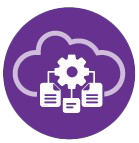California Cloud Smart

The Journey to Cloud Smart
In the 10 years since CDT’s Cloud First policy was released, much has changed in the world of cloud-based solutions. CDT is making necessary changes to cloud computing policies and cloud service offerings with the California Cloud Services Program, aligning with the Federal Cloud Smart Computing Strategy, embracing enhanced security measures, and improving partnerships and coordination with departments preparing to integrate cloud solutions into their technical service architecture. The California Cloud Services Program will leverage Cloud Smart principles to deliver a path for Agencies/state entities to migrate to a safe and secure cloud infrastructure and will provide support to achieve consistent, maintainable, cost-efficient delivery of services.
Cloud Smart Pillars of Success
California’s cloud smart strategy revolves around four fundamentals, or pillars, for successful cloud adoption. Focusing on improving cloud security posture, standardizing cloud architecture, upskilling state civil service staff, and leveraging statewide cloud contracts will establish a more streamlined approach to navigating cloud options.

Security
Modernized security policies focusing on risk-based decision making, automation, and data-focused protections result in an improved security & supportability posture for the state.
Top benefits of Security:
- Regulatory– Assurance that statewide policies are followed for citizens data protection and privacy requirements.
- Data Protection – Utilizing cloud advanced backup and recovery solutions to improve availability and preservation of citizen data in disaster scenarios.
- Integrity of Systems– Cloud providers update infrastructure and systems to patch for vulnerabilities, operational fixes to ensure citizen data is available and secure.

Cloud Architecture
With California Cloud Services comes standardized Cloud architecture providing consistent, accessible (from anywhere), and timely service delivery to the state. Alignment with Federal Cloud Smart Policies provides new opportunities to utilize shared services, economies of scale, and efficiently manage operational costs.
Top benefits of Cloud Architecture:
- Enhanced Public Services Delivery – Ability to offer uniform, supportable, and consistent cloud services in the state, rapidly meeting the citizen needs and expectations.
- Scalable and Flexibility - Adaptability to meet citizen demand for increase in services and/or new functionality. Cloud monitoring tools allow visibility to scale up and down, as needed. Enables collaboration on shared platforms and sharing valuable data as needed
- Governance & Compliance – Standardized architecture provides more security, visibility, and compliance with state policies.

Workforce Development
California Cloud Services aims to recruit, retain, and upskill fundamental statewide talent for cloud engineering, cybersecurity, and acquisition.
Top benefits Workforce Development:
- Through staff development and utilization of shared statewide services, state civil service staff are given the opportunity to provide the services needed by other Agencies/state entities, reducing the dependency on non-state personnel.
- Cost savings – State staff are typically less expensive than contracted personnel in the long term for supporting information technology across the state.

Procurement
Statewide Cloud procurement contracts improve the ability of Agencies/state entities to purchase cloud solutions through repeatable practices and knowledge sharing.
Top benefits of Procurement:
- Cost Efficiency– Contracts with major cloud providers offer negotiated discounts at Scale and ease of operational cost management.
- Standardization – Utilization of statewide contracts enable easy procurements, billing and provide Security benefits.
- Data Analytics and Reporting – Standardized cloud services presents statewide utilization reporting metrics and analytics.
California Cloud Services
CDT’s California Cloud Services Program introduces a new approach to cloud services where we will work with customers to tailor solutions that best meet the individual department cloud goals and business objectives.
Customers in need of cloud services will now engage with CDT using the new California Cloud Services Assessment (CCSA). The CCSA’s 3 Steps to Success (PDF) will partner customers with knowledgeable architects to review design and planning documentation and recommend cloud solutions or improvements best suited for the maturity level of the department; improving cyber security, return on investment, and cloud architecture across the state.
To learn more, or initiate a new request for cloud services, visit the California Cloud Services pages below.
California Cloud Services Assessment
Review CDT’s Cloud Service Offerings
What’s next?
In the coming months, we will release the 2024 Cloud Smart Strategic Roadmap, providing a comprehensive framework defining the necessary steps and requirements to achieve levels of cloud maturity appropriate for each department. Cloud Readiness and Cloud Adoption Playbooks will also be available, along with cloud architectural standards, best practice guides, and training resources for customers to leverage on the journey to cloud success. CDT plans to begin engaging with customers around existing cloud services in Spring of 2024.
Cloud Computing Policies
Statewide Information Management Manual (SIMM)
-
- 18B Cloud Computing Policy Exemption Form
- 140 Cloud Security Guide
- 141 California Cloud Services Assessment Guide
State Administrative Manual (SAM)
-
- 4819.2 Definitions
- 4906 Enterprise Architecture
- 4981.1 Technology Considerations
- 4983 Cloud Computing Introduction
- 4983.1 Cloud Computing Policy
- 5100 Technology Standards
- 5305.5 Information Asset Management
- 5325.1 Technology Recovery Plan